Mount Airy’s (or Mayberry’s) Ground Steak Sandwich
Andy Griffith, master of homespun cornpone humor beloved by elderly white folks nationwide, was born in Mount Airy, North Carolina in 1926. Mount Airy is not only the homeplace of the sandwich we’ll be exploring today and the birthplace of Andy Griffith, but is also often considered to be the model for TV’s Mayberry. Mayberry was the fictional hometown of Sheriff Andy Taylor, his son Opie, Aunt Bee, his deputy Barney Fife, and the whole cast of characters of the eponymous ’60s sitcom “The Andy Griffith Show.” Though I have fond memories of watching the antics of Mayberry’s kookier denizens as a child, I half-expected contemporary voices to have expressed a less rosy opinion. The Andy Griffith Show was–from my perspective as a middle-aged white man–a charming but ultimately harmless fantasy of small-town America that nevertheless felt familiar to me when I was younger. But it was also almost entirely without representation of people of color. There were Black extras here and there over the course of the show, but only one Black actor in its eight seasons ever had a speaking part, in one episode, in the latter half of its seventh season.
I was instead surprised to find many tributes to and defenses of the show written by Black writers. When Andy Griffith died in 2012 Shani O. Hilton, now Deputy Managing Editor of the LA Times but at that time a journalist working for Buzzfeed, published a piece on news website The Awl about the nuanced racial legacy of The Andy Griffith Show. In it, she describes discussing Andy Griffith and Mayberry with a white friend, who wondered why Shani (or I assume her father, who is also a focus of the piece, or for that matter any Black American especially from the South) would have fond memories of a lily-white show like TAGS.
In her world, and in many worlds, Mayberry is shorthand for a simpler time. And as we all know — we all know this, right? — a “simpler time” is shorthand for a time when white people didn’t have to think about whether they were treating nonwhite people (or women) like humans. As Brooke said, it was mostly the “good old boys” who still clung to the ideals of Mayberry.
“Black and White in Mayberry” Shani O. Hilton, The Awl, July 5 2012.
According to her, The Andy Griffith Show avoided many of the racist tropes of the time by not trying to address them; it “didn’t have a chance to be particularly racist because it didn’t try for anything beyond sweet simplicity.” Rather than a nostalgia for Mayberry, she considers the ongoing interest in the show to be primarily a reflection of the character of Sheriff Andy Taylor himself. The people of Mayberry were petty and silly and often just plain dumb, and Andy stood out as a good cop and a good father mainly by not doing much at all. Or, according to Kathleen McElroy, a Black professor of Journalism who has published multiple works about the show, Andy “was morally satisfying because he insisted on justice and dignity for the have-nots.”
I wrote that the show “is a beloved reconstruction of Southern history, memory and identity that spurs nostalgic notions of community even from African Americans shut out of its original narrative.”
“Why a black woman is fascinated with Mayberry and Andy Griffith” Kathleen McElroy, Stillwater News Press, December 13 2015.
It’s a fancy way of saying it’s easier to fantasize about being in Mayberry than actually watching Mammy in “Gone With the Wind.”
But mainly, it’s a darn good show.
Richard Prince, writing for Black news website The Root, collected the thoughts of several Black writers in an article called “Was ‘The Andy Griffith Show’ Post-Racial?” The piece avoids answering the question posed in its title directly, but does present a largely positive view of The Andy Griffith Show. In particular, it quotes a Rochelle Riley piece, no longer online, from the Detroit Free Press wherein she wrote:
“We watched to see our way of life, one that included spending hours picking plums in the plum orchard, then sitting under a chinaberry tree eating them, or walking along ponds to collect cattails.” “I lived in Mayberry,” she wrote.
“Was ‘The Andy Griffith Show’ Post-Racial” Richard Prince, The Root, July 5 2012.
Though Southern Black folks did not see their own faces represented in the show, many apparently did see their culture reflected in the people of Mayberry, and loved the show for it. It may even have been a point in the show’s favor that it never tackled the social issue of racism in the heavy-handed way that some of its contemporaries tried to. “It would have been the one thing Sheriff Andy could not have solved in a half-hour,” noted Mary C. Curtis in the Washington Post.
This is a blog about sandwiches though, and I’ve gone off on a bit too much of a tangent here about a complicated subject that I don’t feel qualified to address more fully. There are still plenty of criticisms to be made, and that have been made, about the Andy Griffith Show’s avoidance of tough topics. There are certainly criticisms to be made about Mt. Airy itself. It was a great relief though to learn that Andy Griffith and Mayberry are not the coded symbols for a Jim Crow era South that I feared they might be, since every recipe for and article about this sandwich namechecks one or the other or both. I may not have gone to Mount Airy to try this sandwich in person, but researching it and eating it at home felt very much like a visit to Mayberry.
The “Ground Steak Sandwich,” almost entirely unknown outside Mt Airy, is a loosemeat sandwich similar to a Maid Rite, served in a hamburger bun and dressed with tomato, coleslaw, and mayonnaise. Some of the restaurants in Mount Airy add mustard, or use it instead of mayo, or maybe even add some diced onion, but the basics–loose ground beef, slaw, and tomato–appear to be relatively static. Whereas a Maid Rite’s meat is mainly bound together by rendered beef fat, the loose meat in the Ground Steak sandwich gets seasoned heavily with black pepper and then glued together with a combination of flour and water that thickens in the pan.
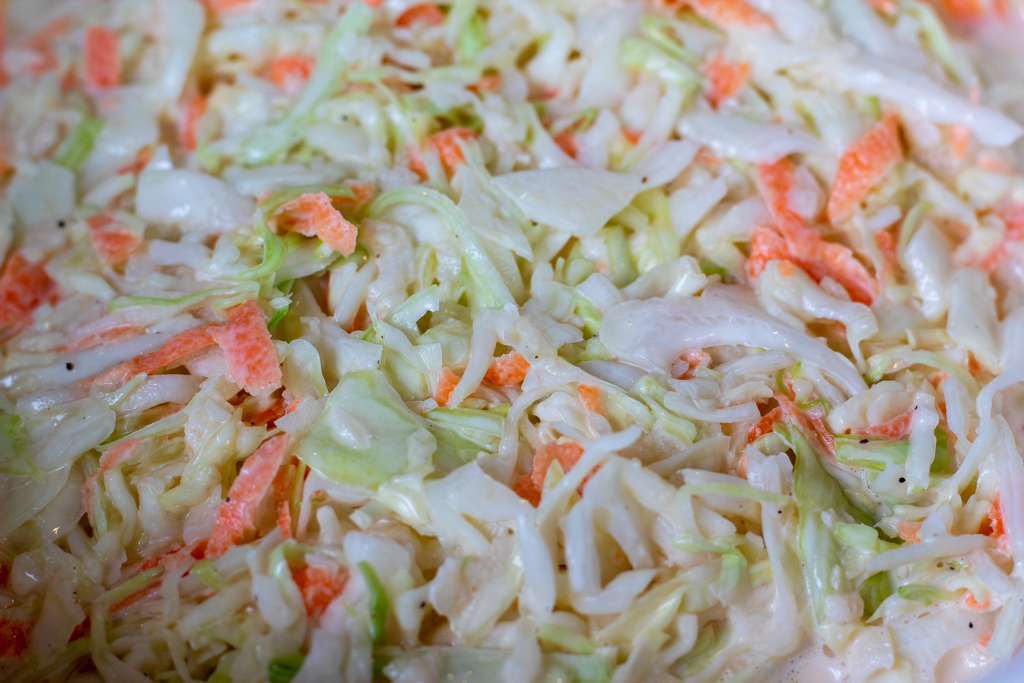
Coleslaw, like barbecue sauce, is a tricky subject in North Carolina. Depending on where you are in the state, the coleslaw might be the typical creamy version found in much of the US, or it might be a reddish vinegar-based version sometimes served with Eastern NC pulled pork. Some halfassed Internet-based research tells me that the standard creamy slaw is the kind found in Mount Airy’s sandwiches. Some recipes for Mount Airy slaw call for diced green pepper; some call for mustard seeds. I went with a very basic recipe; shredded green cabbage, shredded carrots, a little shredded onion, mayonnaise, apple cider vinegar, sugar, a little salt and black pepper. It’s a classic for a reason.

As is often the case with more obscure recipes, every version of this recipe online appears to be the same, cribbed from the original site that published it. They all specify the importance of using ground beef that is 80% lean / 20% fat. They all stress in capital letters that the meat should be peppered LIBERALLY. They all use the word “redolent” to describe the black pepper flavor of the meat. Similarly, the recipe reviews all mention that the resulting sandwich is “greater than the sum of its parts.” As this is a phrase I have used more than a few times on this site, I can’t criticize them too harshly.

Once the ground beef has been fully cooked, the higher fat content of the 80/20 is easy to spot. This excess fat gets drained from the meat, and then a 3:1 mixture of water and flour gets mixed back into the meat, still cooking in the pan.
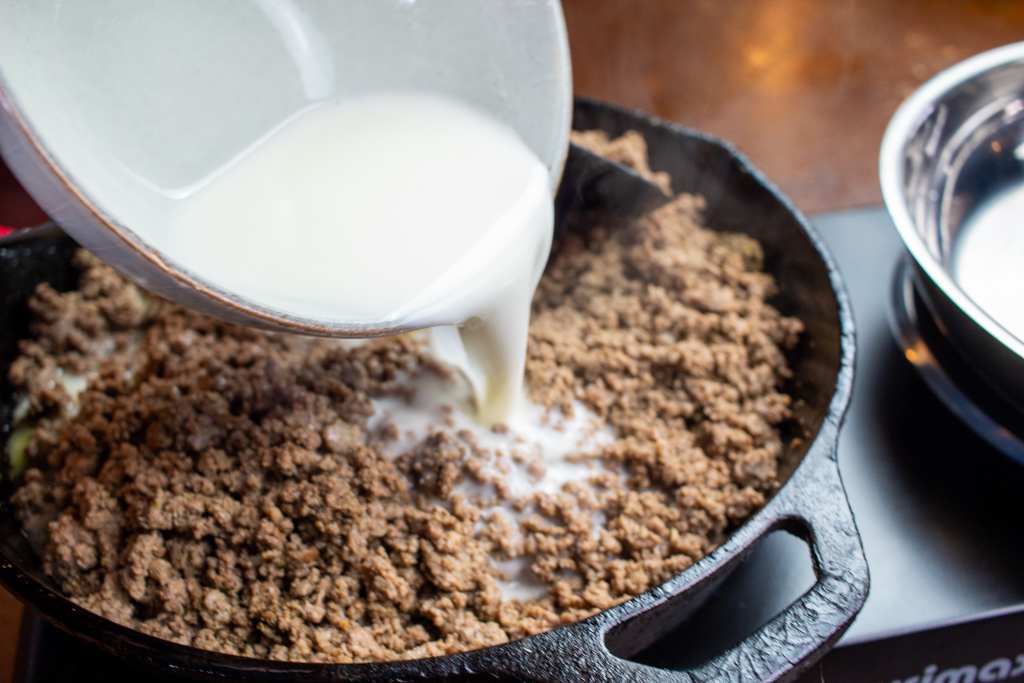
As the flour is heated, it absorbs the water and what fat remains in the pan, creating a thick gluey glaze that coats the ground beef.
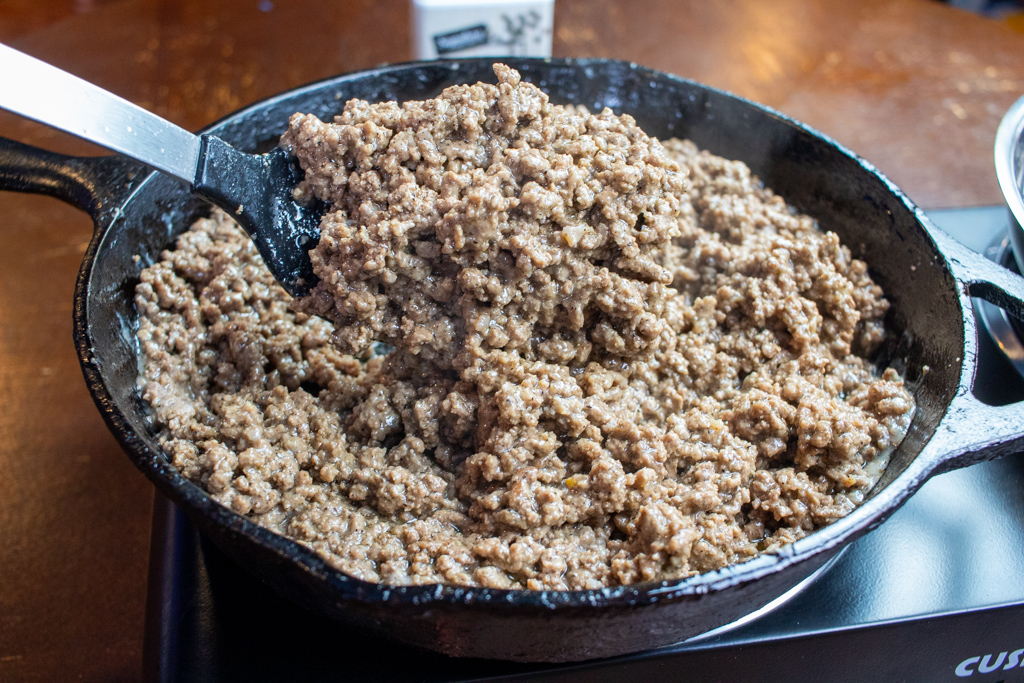
The recipes I found do not specify a type of bread to use for the sandwich, for the most part. However, Google Image Search shows that they are mostly served in plain, squishy white hamburger buns. I went with something slightly less plain and squishy, a package of brioche buns from Aldi.

Most recipes also do not relate whether the hamburger buns are toasted in any way before assembling the sandwich, but I’m guessing they’ll taste better that way, and I do usually prefer things that taste better.
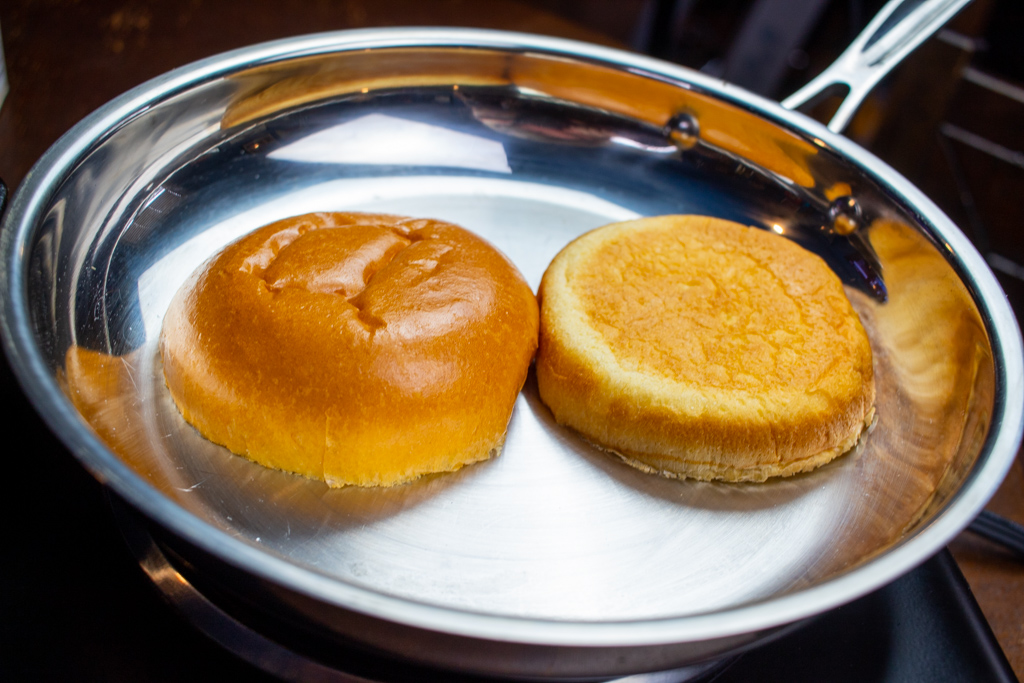
To assemble the sandwich, we take a buttered and toasted hamburger bun

Slap a thick layer of the ground beef on the bottom bun, and spread mayonnaise on the top.
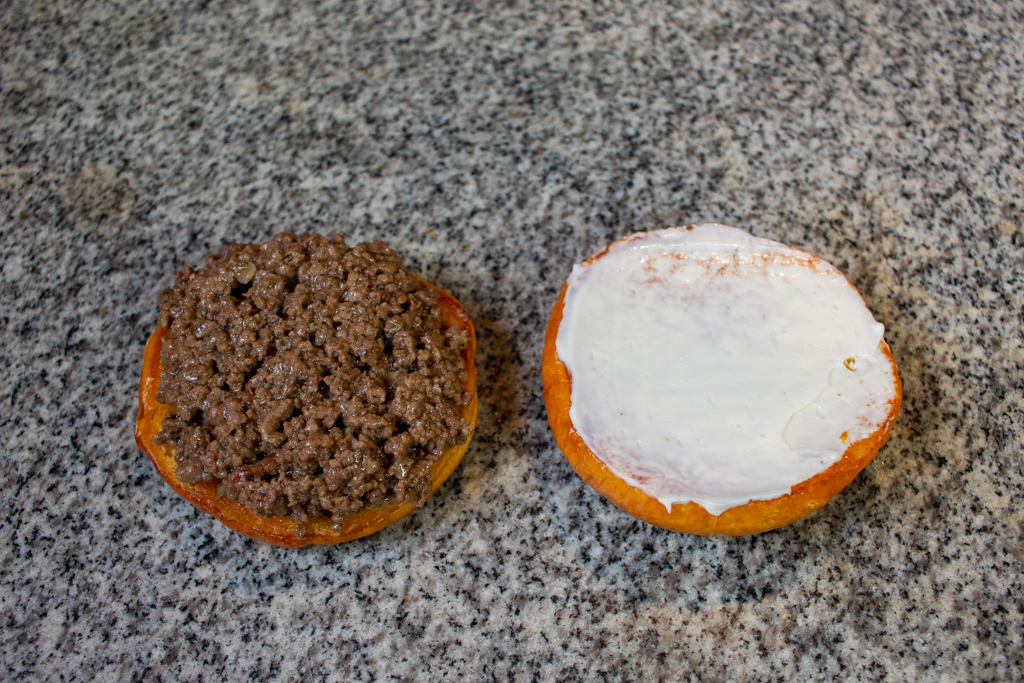
Then add coleslaw and a thick slice of tomato–lightly salted of course.
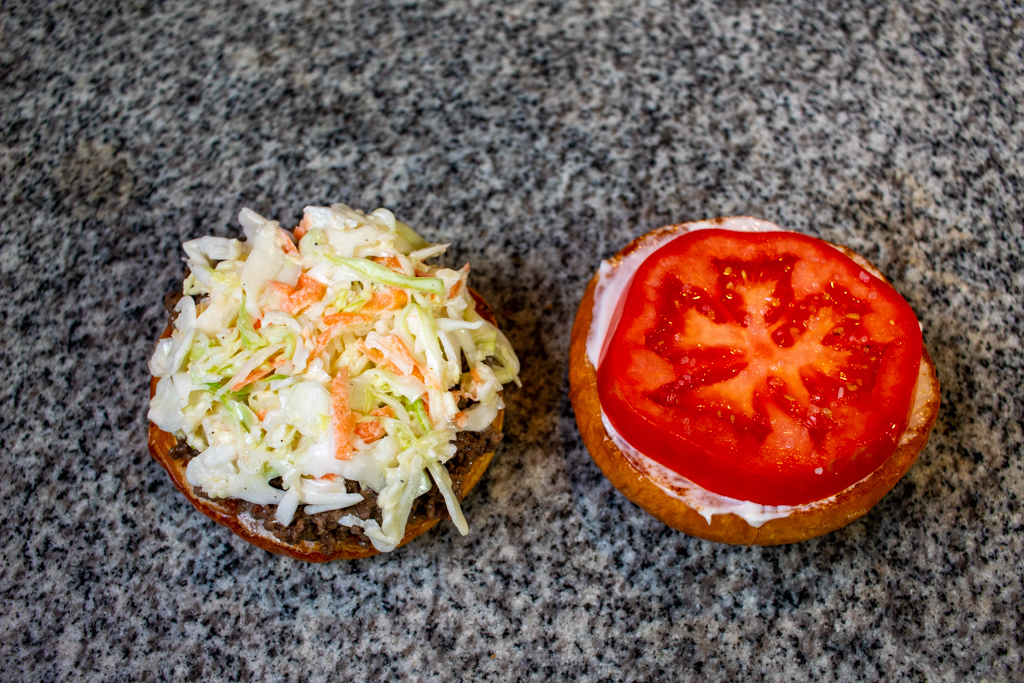
And that’s the sandwich!
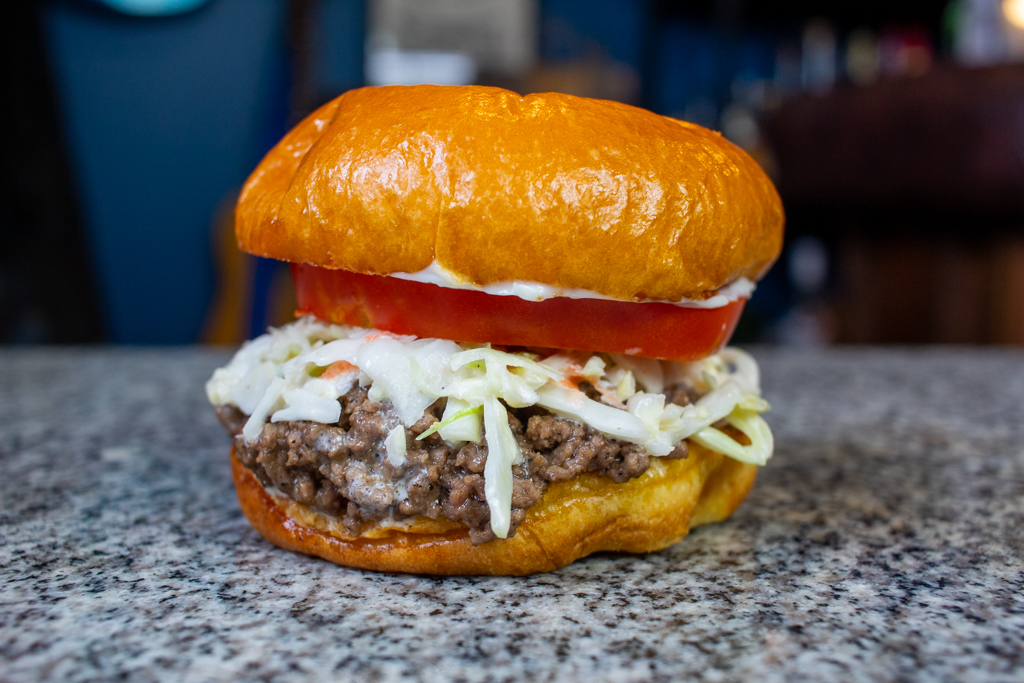
I did not measure my use of black pepper when seasoning the ground beef. Instead, I added as much as I thought two pounds of beef ought to need, then added some more just in case. And the beef itself was indeed “redolent” of the spice and little else. The coleslaw though had a nice oniony bite, and the mayonnaise/tomato combination made the sandwich very refreshing. As one might imagine, the sandwich did not hold together very well, and I hope that the diners in Mount Airy either use sturdier buns than I did or wrap the sandwich in a wax paper diaper to help keep it in one piece.
It tasted good, but it didn’t quite attain that “greater than the sum of its parts” status that the recipe reviewers had promised. However, as noted in some of the articles about the sandwich, there are alternative versions. Yellow mustard is mentioned from time to time, as are diced onions.




While I didn’t feel the onion added much, the mustard made this version of the sandwich superior to the first that I’d tried. That pungency of the mustard combined with the slight sweetness of the coleslaw in a way that very nearly did make this sandwich exceed the sum of its parts.

The ground beef reheats well, though refrigeration does rob the meat of its ability to adhere to itself the way it does fresh out of the pan. Adding a few drops of water, to rehydrate the floury glue holding it together, may help with this. Or you can do what I did and melt a slice of American cheese into the meat.
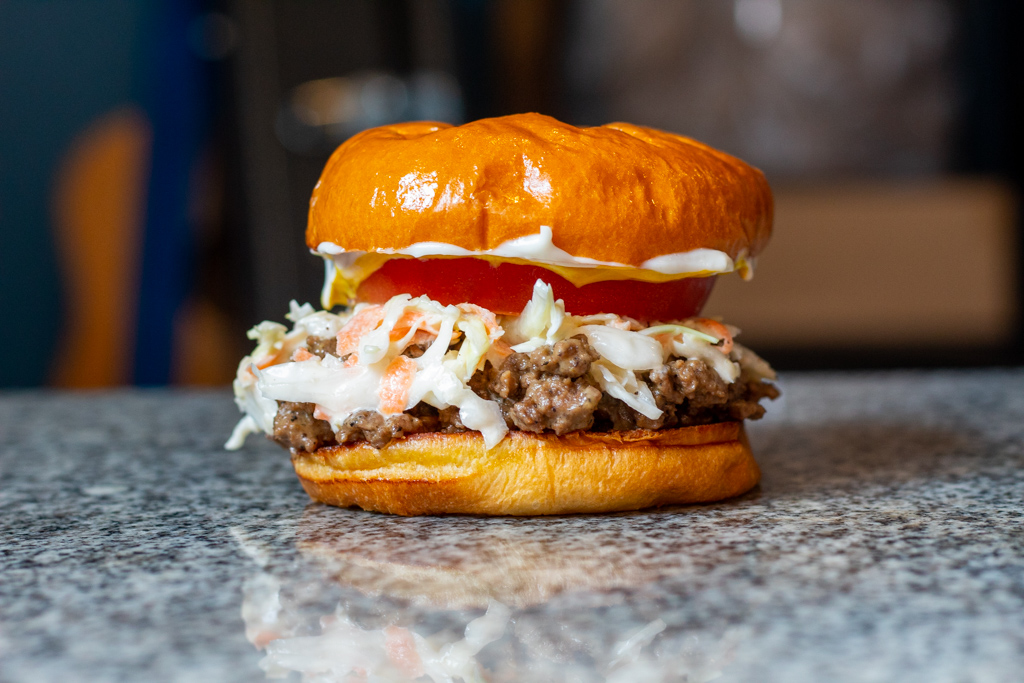
I don’t anticipate ever having a need to visit Mount Airy, North Carolina. If I do, though, it’s good to know there are a number of local mom-and-pop type restaurants serving a tasty sandwich that cannot be had beyond the town’s borders. I also don’t have much reason to revisit The Andy Griffith Show–every episode was filmed and aired and syndicated into reruns before I was born 50 years ago. But it’s also good to know that watching and enjoying the show is a more universal experience than I had feared.

I like sandwiches.
I like a lot of other things too but sandwiches are pretty great


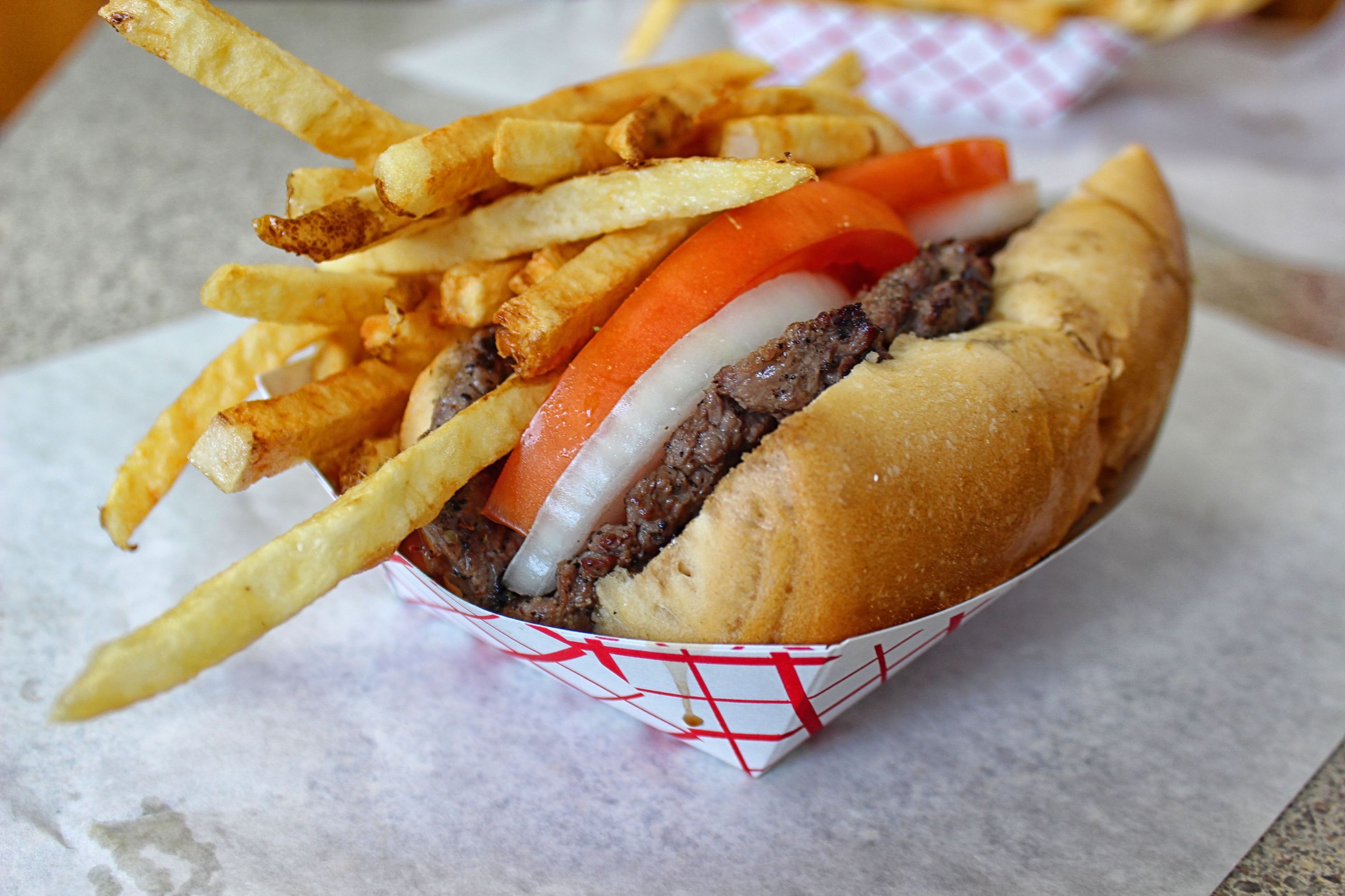








I grew up in Mount Airy and my grandmother regularly served our family ground steak sandwiches (like once every three weeks). I had no idea this sandwich is not more widely known outside of my hometown.
My grandmother often cooked the meat with finely chopped onions which added a savory sweetness. We then topped sandwiches with yellow mustard, fresh chopped onions, and tomato. We rarely used mayo or cole slaw. Some of us would add Texas Pete hot sauce for peppery heat.
If you change your mind and visit Mount Airy, try the ground steak sandwiches at Odell’s drive-in or the Dairy Center restaurant!
I grew up in Ararat, Va. When we “went to town”, we went to Mt. Airy. The Dairy Center and O’Dell’s were the main places we went to get sandwiches and ice cream. I loved the ground steak sandwiches (though mama always thought I messed them up by putting some mustard on them). Anyway,this brings back memories that seem like a lifetime ago. Tomorrow I’m going to make ground steak sandwiches and hope I can get close to the way they tasted back then!🙏
It is worth watching the Andy Griffith Show to learn of a true way of living; “the good old days” where love and respect for others, morals, and family values were a typical, normal, standard way of life! Wish we could go back to that way of life…”You know what I think I gonna do, go get me a ground steak sandwich!” Thankful for Mayberry!
I recently took a trip to NC and because of hurricane Helene traffic re-routed me and I literally “stumbled” upon Mt. Airy, the Andy Griffith parkway, and “Mayberry”. I stopped at Aunt Bea’s Smokehouse BBQ Dairy Bar where I tried the ground steak sandwich, which I had never heard of before. It was a nice sandwich, but the best part was trying something apparently only from that area. I had a wonderful, though very unexpected, day, and will be trying this recipe now that I’ve found it, but with an Arkansas flair.